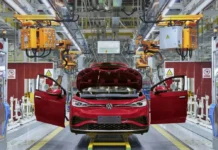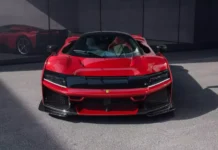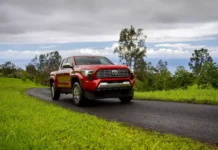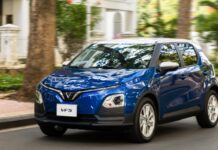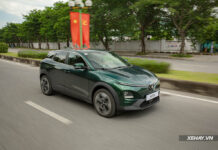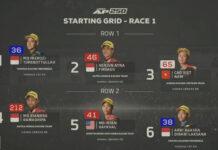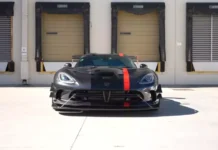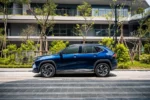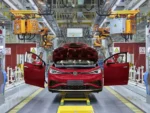The Ford Focus once epitomized “affordable fun” in Europe and was a favorite among Vietnamese drivers for its exhilarating driving experience. This iconic model has now been discontinued, leaving us to anticipate an even better version in the future.
Farewell to the Ford Focus

The Ford Focus is set to end its global production this year, marking a bittersweet moment for Ford enthusiasts worldwide, especially in Europe. The reason is simple: the Focus was exceptional in numerous ways.
Launched in 1998 as the successor to the Escort, the Focus eschewed the rounded design of the 90s, opting instead for sharp lines and long curves—a “New Edge” design language that made it stand out against contemporaries like the Astra and Audi A3.
What truly set the Focus apart was its exceptional driving dynamics. Praised by both critics and customers, the Focus was a modern Ford for a modern generation.
Focus – A Ford for a New Generation
In Europe and America, it’s often said that everyone has a Ford story. Before the Focus, there were countless options: parents drove Escorts, kids were chauffeured in Cortinas, youth was spent in Capris, and Transits handled daily deliveries (a tradition that continues today). By the time the Focus arrived, the Cortina was a fond memory, and the Escort had peaked.
The Focus became the Ford for a new generation, offering hatchback, sedan, and wagon variants to suit every family. Its diverse engine options made it perfect for new drivers ready to explore the world.

The first-generation Ford Focus
The Focus’s driving prowess was the brainchild of engineering genius Richard Parry-Jones and his team. The secret lay in the rear “Control Blade” suspension—a multi-link design that reduced noise, improved road grip, and was cheaper than competitors’ less advanced solutions.
The result was astonishing: the compact Focus could out-corner cars costing many times more. This engineering mindset propelled Ford forward, forcing rivals to up their game.
Of course, high-performance variants were inevitable. The Focus did not disappoint.

First came the ST170—a sporty 2.0L hatchback with high revs and thrilling handling, a bold statement from Ford. Despite its understated looks, it built a loyal fan base.
Then came the RS—a game-changer. Its 2.0L turbo engine delivered 212 hp and 229 lb-ft of torque, hitting 0–100 km/h in around 6 seconds and topping out at over 225 km/h. The first RS was raw, loud, and front-wheel-drive, offering pure driving pleasure for speed enthusiasts.
Second Generation – A Tough Act to Follow

The second-generation Ford Focus
The second-generation Focus faced high expectations. While retaining its driving dynamics, increased size and weight dulled its edge. Its design was criticized as unattractive (and the U.S. version is best left unmentioned).
However, this generation aged gracefully. It became more refined, better equipped, and less aggressive. It could park beside an Audi without feeling out of place. Variants included sedans, hatchbacks, and even a rare hardtop convertible.
The new ST arrived in bold orange, featuring a Volvo-shared 2.5L turbo inline-five engine with a roaring exhaust and rebellious character—a stark contrast to the refined Golf GTI.
The RS was even more extreme: 301 hp, 325 lb-ft, and a top speed over 260 km/h. Its massive power to the front wheels made torque steer unavoidable, even with the advanced Revoknuckle suspension. Yet, its over-the-top nature made it legendary, especially in bright green with a massive spoiler.
Third Generation – Globalization and “Drift Mode”

In 2010, the third-generation Focus debuted as a global model, available from Paris to Los Angeles with easy maintenance worldwide. Its initial design was controversial, but a facelift later improved its appeal.
The ST remained impressive, but the new RS made history: a 2.3L EcoBoost engine with 345 hp, AWD, advanced grip technologies, and a groundbreaking Drift Mode—allowing even novice drivers to drift with excitement. It’s considered one of the greatest hot-hatches ever.
Final Generation – Changing Times

Launched in 2018, the fourth-generation Focus embraced a more premium design and advanced technology, reflecting market trends.
While there was no RS, the ST remained powerful with a 2.3L engine producing 276 hp and a limited-slip differential. However, it wasn’t the best ST, merely “fun to drive.”
Tastes had shifted. Compact SUVs dominated, and governments pushed electric vehicles. The Fiesta was discontinued, and the Focus followed suit.
An Era Ends
The Focus was (and remains, until production ends) an excellent family car: spacious, fun to drive, efficient, and affordable. Millions of memories were made in Focuses: first drives, first kisses, first trips, even first accidents.
Now, that journey ends. The sad news is the Focus is gone. The silver lining is that millions remain on the road, and one day, pristine third-generation Focus RS models will become highly valuable collectibles.
Vietnam Market: Ford Focus – From a Great Driver’s Car to Discontinuation
In Vietnam, the Ford Focus was officially distributed from the early 2000s, competing in the C-segment against the Toyota Corolla Altis, Mazda3, Honda Civic, and later the Kia Cerato/K3.
The Focus’s strength in Vietnam was its superior driving dynamics—precise steering, stable handling, and a solid chassis, offering a rare driving pleasure in its class.
Ford equipped the Focus with advanced safety and convenience features, staying ahead of competitors.

However, the Focus had significant drawbacks that limited its mass appeal:
Compared to the Corolla Altis or Mazda3, the Focus’s design was considered “hard” and less appealing to Vietnamese buyers, who preferred softer, more luxurious styles over sporty, edgy designs.
Maintenance and parts costs were higher than Japanese and Korean competitors, with longer wait times for replacements. Frequent minor issues further deterred customers.
Poor resale value: In Vietnam’s used car market, Toyotas are favored for reliability. The Focus, despite its driving pleasure, depreciated quickly, making buyers hesitant.
In recent years, consumers shifted to compact SUVs like the Ford EcoSport, Hyundai Kona, Mazda CX-5, and Toyota Corolla Cross. Sedans and hatchbacks lost appeal, and the Focus couldn’t compete. Ford Vietnam decided in 2018 to focus on SUVs and pickups, phasing out the Fiesta and Focus.
Like its global story, the Vietnamese Focus was a great driver’s car that created many memories but couldn’t adapt to changing consumer trends and Ford’s strategic shift. For its owners, the Focus was more than a car—it was a trusted companion, remembered as one of Vietnam’s best-driving cars.

